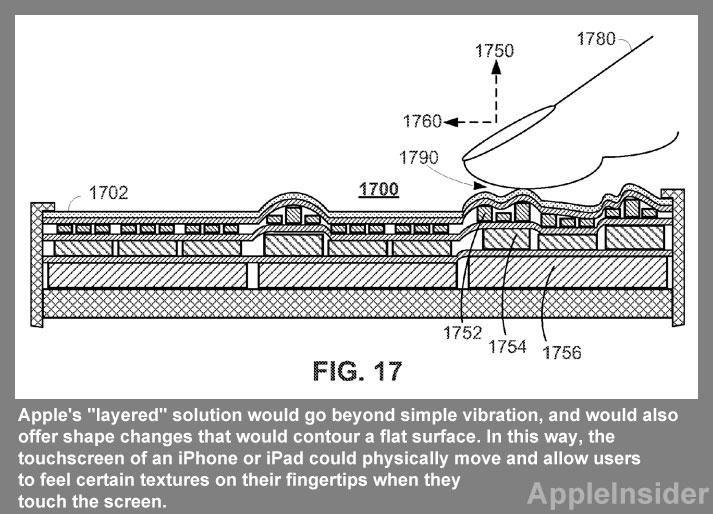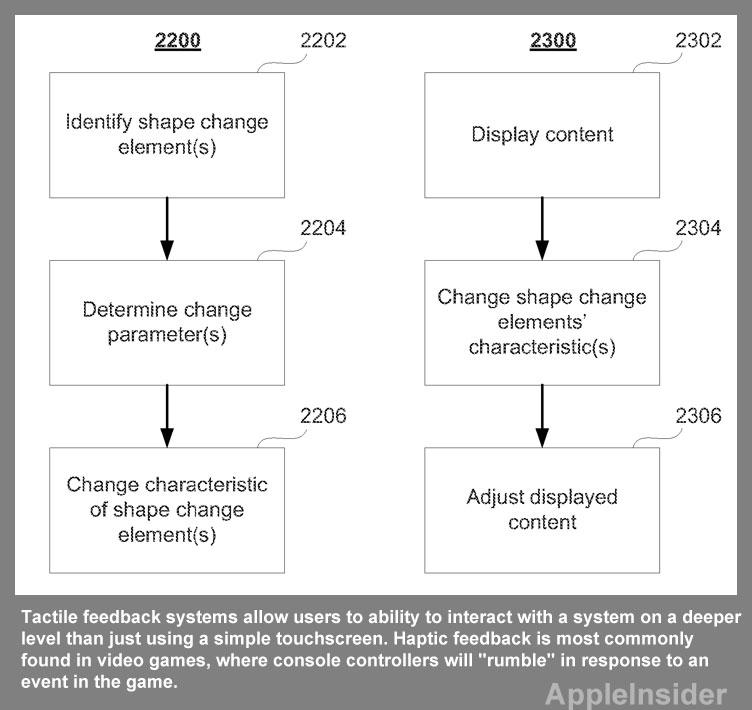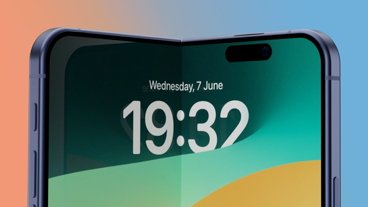Apple has shown interest over the years in making touchscreens more immersive and responsive to users with haptic feedback. In March, it was even suggested that Apple had been in contact with a company called Senseg, which sells technology that uses electric fields to simulate complex, context-sensitive textures on a touchscreen device.
A newly published patent application from Apple, and discovered by AppleInsider, aims to offer the same ability to make a touchscreen feel smooth, rough or otherwise, but through different methods. The proposed invention, entitled "Methods and Systems for Providing Haptic Control," features a tiered haptic system that would be formed by stacking haptic elements.
"One or more arrays of shape change elements such as, for example, piezoelectric elements may be used to actuate a screen surface," the filing reads. "Arrays may also be used to sense tactile interactions and stimuli on a screen surface.
"An embedded haptic system may be formed by inserting haptic elements into a contoured elastic sheet. The embedded haptic system may provide tactile interactions to a user. In some embodiments, both tiered and haptic arrangements may be used."
Apple's filing notes that tactile feedback systems allow users to ability to interact with a system on a deeper level than just using a simple touchscreen. Haptic feedback is most commonly found in video games, where console controllers will "rumble" in response to an event in the game.
But Apple's "layered" solution would go beyond simple vibration, and would also offer shape changes that would contour a flat surface. In this way, the touchscreen of an iPhone or iPad could physically move and allow users to feel certain textures on their fingertips when they touch the screen.
The latest application isn't the first time Apple has shown detailed interest in advanced haptic feedback technology. In March, AppleInsider was also the first to report on a similar patent application that described using piezoelectric actuators for "localized haptic feedback," allowing users to feel a virtual button on their fingertips.
n 2010, Apple also filed a patent application for what it called a "multi-haptic" system that would detect multi-touch gestures and provide a number of physical feedback responses accordingly. And in 2009, before the iPad was announced, one application described a tablet-style device with a dynamic surface that would give users tactile feedback when typing in order to identify individual keys on their fingertips.
The latest proposed haptic feedback invention from Apple, published this week by the U.S. Patent and Trademark Office, was first filed in October of 2011. It is credited to Michael D. Lampell, Francois-Yves Bertrand, Alan Berfield, Leo Lee, and Eric Snider.
 Neil Hughes
Neil Hughes








-m.jpg)






 Charles Martin
Charles Martin
 Christine McKee
Christine McKee
 Wesley Hilliard
Wesley Hilliard
 Malcolm Owen
Malcolm Owen
 Andrew Orr
Andrew Orr
 William Gallagher
William Gallagher
 Sponsored Content
Sponsored Content








12 Comments
Now I am getting interested in the iPad
These patents sound like they are years away from Apple even deciding if they WANT them in a product. Durability and other concerns would make me shy away from putting the early versions of anything like this in a product that ships in the tens of millions.
Still, I’m all for innovation and invention! Practical or not, I’m glad people are thinking in these ways. Apple patents a ton of new ideas, and a few of the most exotic ones might ship one day.
These patents sound like they are years away from Apple even deciding if they WANT them in a product. Durability and other concerns would make me shy away from putting the early versions of anything like this in a product that ships in the tens of millions.
Still, I’m all for innovation and invention! Practical or not, I’m glad people are thinking in these ways. Apple patents a ton of new ideas, and a few of the most exotic ones might ship one day.
Perhaps Apple is a few years away from shipping tactile sensations on a touchscreen device but it is notable that Apple has been investigating tactile feedback for several years. A press release from Senseg in January 2012 is also notable:
Senseg Unveils First Feelscreen Product
Senseg’s Patented Technology Produces Tactile Sensations for
Touch Interface Devices
JANUARY 10, 2012, HELSINKI and CUPERTINO, CA – Senseg, the leader in next-generation haptic technology, today announced that it has unveiled the first production-ready product that adds tactile effects to touch interfaces with a completely solid state solution—turning touch screens into ‘feelscreens’. The company’s patented technology, which produces tactile sensations on users’ skin, will be integrated into a new generation of touch interface devices. Senseg’s solution delivers a new dimension of interactive experiences–including textured surfaces, contours and edges–that add the dimension of feel to touch interfaces.
Senseg expects its first customers, which will be Original Equipment Manufacturers (OEMs), to integrate Senseg’s technology into consumer products in the next year. Customers can license the Senseg hardware and software to create feelscreen applications in areas ranging from games to productivity applications, social shopping, and enhanced user interfaces.
According to DisplaySearch, the global touchscreen market will reach $9 billion by 2015, and the company lists twelve major technology areas for this market; Senseg’s technology plays in several of these areas. Senseg was recently named to TIME Magazine’s ’50 Best Inventions’ list.
When Senseg’s technology is incorporated into a touch interface device, application developers will have precise control over the specific location and type of haptic effects that users experience. Senseg effects have a very broad dynamic range, both in the type of effect delivered as well as the effect’s intensity. With Senseg, application designers can use feel to both guide and reward user actions, whether it is used to minimize visual focus required for accurate operation, or to enrich a multi-modal experience that incorporates graphics, sound and touch.
“Senseg provides a complete suite of patented technologies for hardware and software developers to provide immediate tactile responses, delivering a new dimension to any touch interface. We can enhance the visual content on a display with touch feedback that creates the sensation of moving a vinyl record on a DJ music app, feeling sand when accessing images of the Gobi Desert, or feeling the corner of a page when reading an e-book on a tablet,” said Ville Mäkinen, the founder and CTO of Senseg. “We have created highly efficient solutions that provide the precise tactile sensations right at the location of the user’s finger without shaking the whole device and yet consume very little power on mobile devices.”
If they could get the resolution high enough they could use the display to display brail. This would open up a whole new client base of blind people who could now use the iPad to read books and magazines.
Interesting. We're all used to iOS responding instantly to finger taps (or when we lift up from a tap.) But, if I'm reading the article right, haptic feedback displays would let iOS respond when users actually push down configurable buttons / keys. Not just when resting a finger on the screen.
This means that taps could, in theory, have two semantic meanings: 1. do something when a finger touches or lifts off from the screen, or 2. do something when a user physically clicks on a raised haptic button. So the SDK could in theory provide two different types of buttons: haptic and non-haptic. An example of a non-haptic button would be some kind of game-play button when the user taps something on the screen. Faster to not require a physical click, and some tappable items would be so big that making them into a raised button would make little sense. Haptic buttons could, of course, include keyboard keys, Done buttons, etc.
I'm not sure that Apple would want to add that extra level of complexity to the iOS UI. Oh, and by the way, you can change the letter you're typing (on the default keyboard) by tapping, holding, and dragging your finger until the right letter appears. The letter isn't added to the input field until you lift.
(@ KyleG: yes, maybe the haptic elements could be more for Accessibility features than for basic app interfaces.)